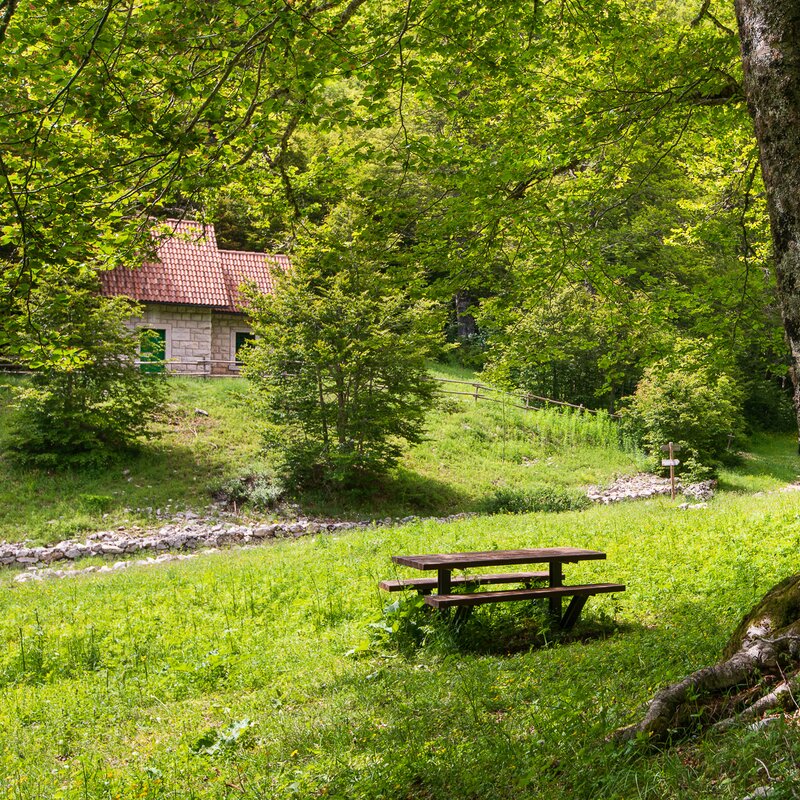Terraegna mountain hut obtained in 2018 acknowledgment from European Charter for Sustainable Tourism in Protected Areas: a practical management tool that enables Protected Areas to develop tourism sustainably. The core element of the Charter is the collaboration between all interested parties to develop a common strategy and action plan for tourism development, based on an in-depth analysis of the local situation. The objective is the protection of the natural and cultural heritage and the continuous improvement of tourism management in the protected area in favor of the environment, the local population, businesses and visitors.
We offer a continental breakfast, with homemade cakes and good moka coffee. At dinner we enjoy traditional Abruzzo dishes such as maccheroni alla chitarra, ravioli with L'Aquila saffron, soup with orapi and beans or codetti with potatoes and ricotta cheese. Depending on the availability of the season, it is possible to taste many other local products such as Picinisco pecorino cheese, caciocavallo cheese and scamorza from Villetta Barrea.
What's included
Bed with pillow and blankets
Continental breakfast
Three-course dinner (half board)
What is excluded
Drinks and wines
Personal extras
From Pescasseroli
Templo – Vallone Filarello
Path Z1-A1 PNALM
Vertical drop 450 m
Average time 2 h
From Pescasseroli
Valle di Prato Rosso – Terraegna
Path A1 PNALM
Vertical drop 610 m
Average time 3.30 h
From Bisegna
Gole d’Appia – Terraegna
Path A1 PNALM
Vertical drop 520 m
Average time 2.30 h
From Scanno
Scanno – Valico del Carapale
Path A3-A1 PNALM
Vertical drop 1000 m
Average time 4 h
From Villalago
Villalago – Valico Argatone
Path W3-A1 PNALM
Vertical drop 920 m
Average time 4 h
Thanks to its position, the Rifugio Terraegna offers the possibility of following several panoramic routes, all of which are accessible and clearly signposted.
Monte Argatone(Path W3 PNALM) 1 h
Valico del Carapale(Path A1-A3 PNALM) 2 h
Valico della Corte(Path A1-A4 PNALM) 3 h
Monte Marsicano(Path A1-A6 PNALM) 5 h
In the most hidden corner of this land still survives an ancient beech forests, as in Coppo del Morto and Codone, where the patriarchs reach 500 years of life. These trees have been born before the end of the Middle Age and before the “discovery” of Americas by Columbus. Therefore, these are not only the oldest beech trees known in Europe but also the oldest broad-leaf trees of the Northern hemisphere! Such an amazing discovery has brought the magnificent Apennine beech forests to the attention of the international scientific community and also triggered their nomination process as “UNESCO World Heritage Site”. In these primeval forests, the concentration of species is impressive.
Apennine Wolf Canis lupus italicus (Linnaeus, 1758)
Barbastelle Bat Barbastella barbastellus (Schreber, 1774)
Black Kite Milvus migrans (Boddaert, 1783)
Collared Flycatcher Ficedula albicollis (Temminck, 1815)
Golden eagle Aquila chrysaetos (Linnaeus, 1758)
Marsican brown bear Ursus arctos marsicanus (Altobello, 1921)
Meadow Viper Vipera ursinii (Bonaparte, 1835)
Peregrine Falcon Falco peregrinus (Tunstall, 1771)
Red-backed Shrike Lanius collurio (Linnaeus, 1758)
Rosalia alpina Rosalia alpina (Linnaeus, 1758)
Rock Thrush Monticola saxatilis (Linnaeus, 1766)
Snowfinch Montifringilla nivalis (Linnaeus, 1766)
Tawny owl Strix aluco (Linnaeus, 1758)
Treecreeper Certhia brachydactyla (Brehm, 1820)
White-backed Woodpecker Picoides leucotos (Bechstein, 1803)
Reviews
FAQ
Day tours can be cancelled without penalty up to 48 hours prior to departure. Cancellations made after this time will incur a 100% cancellation fee and will not be refunded. For more information on booking conditions click here
We regret that we cannot accept dogs at the mountain cabin.
